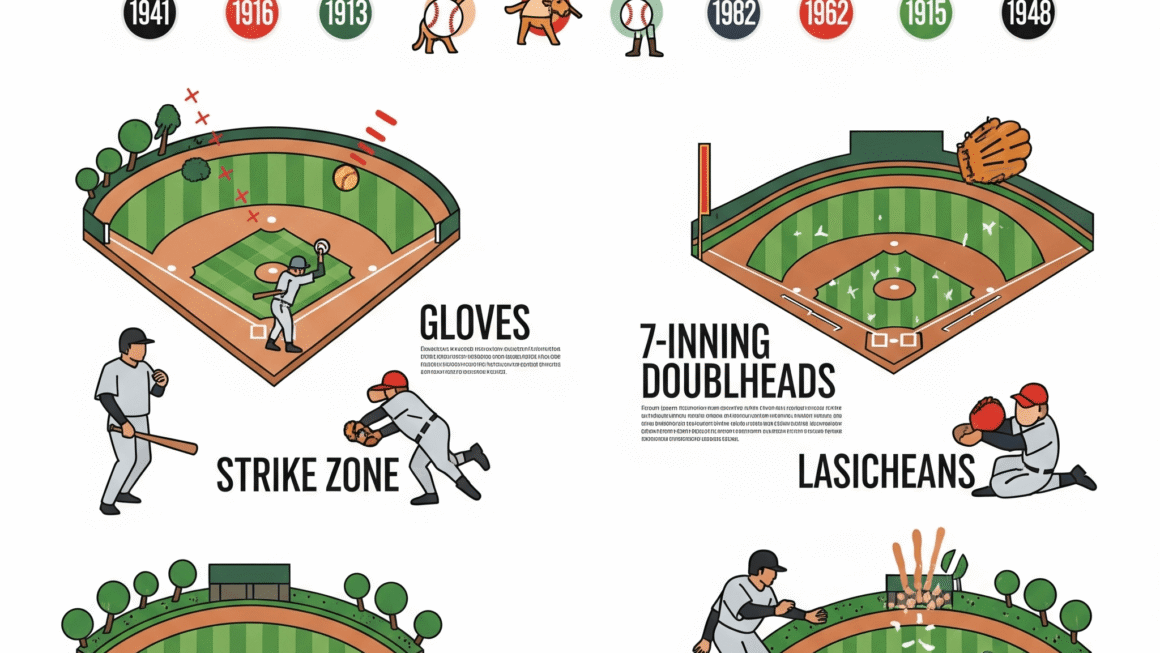Here’s something that’ll blow your mind: Babe Ruth never faced a single relief specialist. Not one. The greatest home run hitter in baseball history spent his entire career swinging against starting pitchers who were expected to finish what they started. Fast-forward to today, where hitters face fresh arms throwing 100+ mph in the seventh inning, and you start to understand how dramatically baseball has evolved beneath its seemingly unchanging surface.
Baseball loves to market itself as timeless, but the sport has undergone more strategic transformation than a chess grandmaster’s playbook. Every rule change, no matter how minor it appears, creates ripple effects that reshape how teams build rosters, deploy players, and approach critical game situations. What looks like simple tweaks to casual observers represents seismic shifts to the players, coaches, and sharp bettors who understand the game’s deeper complexities.
When tradition meets innovation — baseball’s reluctant rule revolution
Baseball’s relationship with change resembles a stubborn grandfather who finally agrees to use a smartphone after his grandkids threaten to stop calling. The sport clings to tradition like ivy to Wrigley Field’s outfield walls, but eventually succumbs to pressure when attendance drops or games drag past midnight.
The most fascinating aspect of baseball’s evolution isn’t the rules themselves — it’s how teams exploit unintended consequences. When MLB lowered the pitcher’s mound in 1969 to help hitters, nobody predicted it would eventually lead to the bullpen specialization that dominates today’s game. That five-inch adjustment created a butterfly effect that took fifty years to fully manifest.
Consider the designated hitter rule, introduced in 1973 as a simple offensive boost. What seemed like straightforward roster construction — add one good hitter, remove pitcher hitting — actually revolutionized strategic thinking. Managers could suddenly pinch-hit more aggressively, knowing they wouldn’t lose their pitcher. American League teams began constructing rosters differently, prioritizing power over speed and defensive versatility.
The unintended specialist revolution
Every rule change creates new specialist roles that didn’t previously exist. The three-batter minimum for relief pitchers, implemented in 2020, was designed to speed up games by reducing pitching changes. Instead, it forced teams to roster different types of relievers and fundamentally altered late-inning strategy.
Economic pressures driving change
Modern rule changes often stem from business concerns rather than competitive balance. When games regularly exceed three hours and younger demographics lose interest, owners pressure commissioners to act. These financially motivated adjustments can have more profound strategic consequences than changes made purely for competitive reasons.
Technology’s invisible influence
Advanced analytics revealed inefficiencies in traditional strategies, forcing rule makers to respond. When teams discovered optimal defensive positioning reduced offense to unwatchable levels, MLB introduced shift restrictions. The sport essentially regulated itself out of strategic innovations that were too effective for entertainment purposes.
The dead-ball era to steroid summers — how equipment rules reshaped offense
Baseball’s offensive evolution reads like a pharmaceutical experiment where scientists kept adjusting the formula until they achieved desired results. The transition from dead-ball to live-ball eras wasn’t just about baseballs — it represented a complete philosophical shift about what baseball should entertainment-wise deliver.
The 1920 introduction of livelier baseballs didn’t just increase home runs; it revolutionized defensive positioning, pitcher usage patterns, and roster construction. Teams that adapted quickly — like the Yankees building around Babe Ruth’s power — gained competitive advantages that lasted decades. Franchises that clung to dead-ball strategies found themselves irrelevant within seasons.
Equipment standardization had equally profound effects. When MLB mandated uniform ball specifications in the 1970s, it eliminated the home-field advantages teams gained from using balls suited to their park dimensions. Suddenly, road teams couldn’t blame losses on unfamiliar equipment, and statistical comparisons became more meaningful across different stadiums.
Bat regulations and hitting philosophy
Wooden bat requirements forced hitters to develop different swing mechanics than they used in amateur baseball with aluminum bats. This created a minor league development challenge where prospects needed to completely retrain their approach. Teams that invested in better hitting instruction gained edges in player development.
Uniform and safety equipment evolution
Modern protective gear allows players to stand closer to the plate and dive for balls more aggressively. Catchers wearing better equipment can block pitches differently, affecting how pitchers attack the strike zone. These seemingly minor equipment improvements accumulated into significant strategic advantages.
Stadium dimension standardization pressure
While field dimensions remain variable, pressure exists to standardize aspects like foul territory and wall heights. Any movement toward uniformity would dramatically affect how teams construct rosters and develop park-specific strategies.
Pitching transformations that turned strikeouts into spectacle
Modern baseball has become a strikeout festival that would horrify purists from previous eras. In 1988, the league-wide strikeout rate was 14.5%. By 2022, it had skyrocketed to 22.4%. This isn’t just about better pitchers — it’s about rule changes that fundamentally altered the pitcher-hitter dynamic.
The strike zone’s gradual expansion over decades gave pitchers more area to attack while hitters struggled to adjust. When umpires began consistently calling high strikes that were traditionally balls, it created new pitch sequences and approaches that emphasized velocity over location. Suddenly, throwing 95 mph became minimum viable, not exceptional.
Pitch count limitations revolutionized how teams develop and deploy pitchers. Starters who once threw 300+ innings annually now rarely exceed 200. This shift created the modern bullpen economy, where teams need seven or eight reliable relievers instead of three or four. The strategic implications are staggering — late-game matchups that once seemed straightforward now involve complex analytical calculations.
The velocity arms race
Rule changes didn’t directly mandate higher velocities, but they created incentive structures that rewarded power over finesse. When hitters became more disciplined and patient, pitchers needed to overpower them rather than outthink them. This led to the current era where 90 mph fastballs are considered soft.
Specialization versus versatility
Modern pitching rules encouraged extreme specialization. Left-handed relievers who can only face left-handed hitters became valuable roster pieces. This specificity reduced strategic flexibility while increasing analytical complexity for managers making in-game decisions.
Injury prevention paradox
Attempts to protect pitcher arms through pitch counts and innings limits may have actually increased injury rates by encouraging maximum effort on every pitch. When pitchers know they’re limited to 100 pitches, they throw each one at peak intensity rather than pacing themselves for complete games.
Modern pace-of-play reforms and their unintended tactical ripple effects
MLB’s recent obsession with game length has produced rule changes that sound minor but carry massive strategic implications. The pitch clock, introduced in 2023, seems like simple time management until you realize it fundamentally altered how pitchers and hitters prepare for crucial at-bats.
Veteran pitchers who built careers on working slowly suddenly faced time pressure in high-leverage situations. Hitters who used deliberate routines to disrupt pitcher timing found themselves rushing through at-bats. These micro-adjustments accumulated into different offensive and defensive approaches that smart teams exploited while others struggled to adapt.
The automatic runner on second base in extra innings represents baseball’s most dramatic recent rule change. What was intended as a simple game-shortening measure completely revolutionized extra-inning strategy, creating new analytical models for when to steal, bunt, or intentionally walk batters.
Here are the key tactical adjustments teams made to pace-of-play rules:
- Bullpen management acceleration — Managers began making pitching changes earlier to avoid rushed decisions under time pressure
- Batting order optimization — Teams restructured lineups to maximize scoring potential with automatic runners in extra innings
- Defensive positioning timing — Fielders needed to communicate shifts faster, leading to simplified defensive schemes
- Catcher signal efficiency — Battery communication became streamlined, reducing complex pitch sequences
- Pinch-hitting preparation — Bench players needed to stay warmer and more ready for immediate insertion
These adjustments prove that even seemingly administrative rule changes create competitive advantages for teams that adapt fastest. Organizations with better analytical departments and coaching flexibility gained edges that translated into additional wins.
Technology integration and the analytics-driven strategy shift
Baseball’s technological revolution didn’t require rule changes — it simply exploited existing rules more efficiently. When teams gained access to detailed data about every pitch, swing, and defensive positioning, they discovered that traditional strategies were often suboptimal.
The shift restrictions implemented in 2023 represent MLB’s attempt to regulate analytical insights that were too effective for entertainment purposes. Teams had become so sophisticated at positioning defenders that they were essentially stealing hits from offensive players. This created the unusual situation where successful strategy needed to be legislated away.
Replay review systems changed how players and managers approach close calls. Knowing that controversial decisions can be overturned affects in-game risk calculation. Base runners take different leads, fielders attempt different plays, and managers save challenges for optimal moments. These behavioral modifications accumulated into different game flows and strategic emphases.
Electronic strike zones remain baseball’s most contentious potential technological integration. If implemented, they would eliminate human umpire judgment and create perfectly consistent strike zones. This would force fundamental changes in how pitchers attack hitters and how catchers frame pitches.
Future rule changes that could revolutionize America’s pastime
Baseball stands at a crossroads where tradition meets technological capability. Several potential rule changes could reshape the sport more dramatically than anything implemented in the past century.
The pitch clock could be shortened further, forcing even faster game pace and potentially eliminating some of baseball’s contemplative aspects. Alternatively, different pitch clock lengths for different game situations — longer in playoffs, shorter in regular season — could create strategic variety that rewards adaptability.
Automated strike zones represent the ultimate analytical integration. Perfect pitch calling would eliminate catcher framing skills, reduce umpire influence, and create statistical purity that might make the game more predictable but less human. The psychological impact on players who have spent careers adjusting to different umpire tendencies would be profound.
The golden at-bat rule — allowing teams one “super” at-bat per game where they can send any hitter regardless of batting order — sounds gimmicky but would create fascinating late-game scenarios. Imagine saving your best hitter for the perfect high-leverage situation, regardless of when their spot comes up naturally.
Will baseball embrace radical change or continue its gradual evolution? The answer might determine whether America’s pastime remains relevant for future generations or becomes a nostalgic curiosity. One thing is certain: every rule change, no matter how small, will create unintended consequences that smart teams will exploit while others struggle to understand what just happened.




